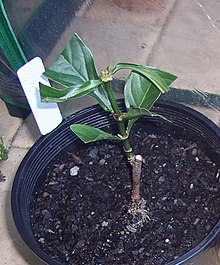Chacruna
| Psychotria viridis | |
|---|---|
 |
|
| A potted, young Psychotria viridis plant shortly after its leaves were clipped for propagation. | |
| Scientific classification | |
| Kingdom: | Plantae |
| (unranked): | Angiosperms |
| (unranked): | Eudicots |
| (unranked): | Asterids |
| Order: | Gentianales |
| Family: | Rubiaceae |
| Genus: | Psychotria |
| Species: | P. viridis |
| Binomial name | |
|
Psychotria viridis Ruiz & Pav. |
|
| Synonyms | |
|
|
Psychotria viridis is a perennial shrub of the Rubiaceae family. In the Quechua languages it is called chacruna or chacrona. In Quechua, chaqruy is a verb meaning "to mix".
P. viridis is a close relative of Psychotria carthagenensis (a.k.a. samiruka or amiruca) of Ecuador. The leaves differ by p.viridis having leaf edges that extend all the way to the base of the leaf stem.
In Ecuador, the name chacruna refers to Diplopterys cabrerana.
P. viridis grows to a height of approximately 5 m (16 ft). Its branches span a diameter of about 2 m (6 ft 7 in)
In the middle and lower parts of the stem, situated between the insertion points of the two opposite leaves there is a horizontal scar 0.3–1 mm (0.012–0.039 in) wide that extends between the leaves (or leaf scars) and sometimes also connects over the tops of these scars, and along the top side of this scar there is a dense, usually furry line of fine trichomes (i.e., plant hairs) usually 0.5–1 mm (0.020–0.039 in) long that are reddish brown when dried. This combination of features is diagnostic for many species in the genus Psychotria, though not for any individual species. These features distinguish Psychotria L. Subg. Psychotria; other subgenera of Psychotria lack the well developed reddish brown trichomes inserted above the stipule scars. On the upper stems of P. viridis these features are obscured by a stipule (see below), which covers the trichomes; the scar actually marks the point where this structure has fallen off.
These are leafy structures that cover and protect the young developing leaves, then fall off leaving scars on the stem. The stipules are produced in pairs, and their form is distinctive for P. viridis. They are 5–25 mm (0.20–0.98 in) by 4–12 mm (0.16–0.47 in), elliptic in outline, sharply angled at the apex, papery to membranaceous in texture, ciliate (i.e., fringed) along the upper margins, and longitudinally flanged or winged along the middle. However, stipule shape and size is quite variable among different plants, and also depends on the stipule's developmental stage and other factors such as whether the stem that produced it is reproductive or vegetative.
...
Wikipedia
